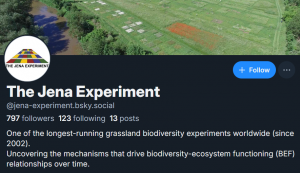New publication from Ding et al. in Soil Biology and Biochemistry: Characteristics and origin of intact polar lipids in soil organic matter

fractional abundances of intact polar lipid classes
Membrane lipids and their related acyl and/or alkyl moieties are important biomarkers of the microbial community in environmental samples. Intact polar lipids, which are described by their lipid head groups and fatty acid tails, are major membrane components of living cells only and may therefore provide information about the living soil microbial community. However, the intact polar lipids in soil organic matter may originate from non-microbial organisms (e.g., roots, soil animals) as well as microorganisms.
We report on the profiles of more than 300 membrane-derived intact polar lipids in grassland soil organic matter from sites with diverse plant communities and soil properties. The origin of the soil lipid profiles was deduced by comparisons with the intact polar lipids of plant roots, amoebae, collembolans, fungi and bacteria. In addition, we investigated the impact of plant and soil-related drivers on the composition of the intact polar lipids in soil organic matter. Soil organic matter lipid profiles were considerably more diverse and evenly distributed than the profiles of roots and soil organisms (amoebae, bacteria, collembolans and fungi). Moreover, the lipid profiles in soil organic matter had more odd-carbon numbered acyl and alkyl chains, ornithine lipids, and phospholipids with low levels of unsaturation, possibly because they are of bacterial origin. We suggest that most of the intact polar lipids in soil organic matter (45–80%) were derived from bacteria, rather than plants, fungi, or soil animals. The PE (31:0) and PE (32:1) lipids were considered as biomarkers for all bacteria, whereas PE (29:0, 29:2 and 30:0) are specific to Gram (+) bacteria and PG (33; 0, 34:1 and 36:2) and OL (36:0, 37:0, 37:1, 39:1 and 39:2) were used to identify Gram (−) bacteria. Bacterial lipids were differentiated from intact lipids of plant roots that typically contain MGDG (36:4) and MGDG (36:6), while fungi have indicative markers of PC (36:4) and PE (36:4). Thus, intact polar lipid profiles complement and advance other approaches, such as fatty acid-based analysis of soil microbial community composition, and may allow for analysis of soil food web structure.
Reference:
Ding, S., M. Lange, J. Lipp, V. F. Schwab, S. Chowdhury, M. M. Pollierer, et al. 2020. Characteristics and origin of intact polar lipids in soil organic matter. Soil Biology and Biochemistry 151:108045. https://doi.org/https://doi.org/10.1016/j.soilbio.2020.108045



